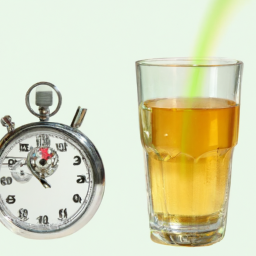I have always had a strong interest in health and wellness, and recently, I’ve discovered the benefits of drinking celery juice. This drink has become popular in the health world for its many advantages, including reducing inflammation, improving digestion, and boosting the immune system. Drinking celery juice regularly can improve overall health and well-being, and it’s easy and cost-effective to make at home.
In this article, I will guide you through the process of making celery juice in a blender. I will provide you with information on selecting the best celery, preparing it for blending, adding other ingredients to enhance the flavor, selecting the right blender, blending the celery juice, and serving and storing it properly. Additionally, I will discuss health and safety considerations, and provide tips on incorporating celery juice into your diet.
By the end of this article, you will have all the information you need to make delicious and nutritious celery juice at home.
Key Takeaways
- Choose fresh celery with bright green leaves and tight, compact stalks
- Use a high-powered blender like Vitamix or Blendtec for best results
- Add lemon juice or ginger for flavor and added health benefits
- Drink on an empty stomach, first thing in the morning for maximum benefits
Benefits of Drinking Celery Juice
You’re going to love how drinking celery juice can improve your health and give you a natural boost of energy! Celery is packed with essential vitamins and minerals that are crucial for maintaining a healthy body.
It contains vitamins A, C, and K, as well as potassium, calcium, and magnesium. These nutrients play a vital role in maintaining a healthy immune system, strong bones, and healthy skin.
Research studies have also shown that drinking celery juice can help reduce inflammation in the body, which is linked to a variety of chronic diseases such as heart disease, cancer, and arthritis. It can also aid in digestion and improve gut health, as celery contains fiber and natural electrolytes that help regulate fluid balance in the body.
With all of these nutritional benefits, it’s easy to see why incorporating celery juice into your daily routine can have a positive impact on your overall health. Now, let’s move on to selecting the best celery for juicing.
Selecting the Best Celery
Okay, folks, let’s get real honest here – not all celery is created equal. When it comes to choosing celery for your juice, there are some freshness factors to consider. You want to look for celery that is crisp and firm, with bright green leaves and tight, compact stalks. Avoid any celery that looks wilted, yellowed, or has soft spots, as this can indicate that it is not fresh.
To help you choose the best celery for your juice, here is a helpful table to reference:
| Freshness Factor | What to Look For | What to Avoid |
|---|---|---|
| Color | Bright green | Yellow or brown |
| Texture | Crisp and firm | Limp and wilted |
| Stalks | Tight and compact | Loose or flimsy |
| Leaves | Bright and green | Brown or wilted |
| Smell | Mild and fresh | Strong or musty |
By selecting the freshest celery possible, you will ensure that your juice has the best taste and maximum nutritional benefits. Now that you know what to look for, let’s move onto preparing the celery.
Preparing the Celery
I always start by cleaning my celery stalks thoroughly before preparing them for juicing. This involves rinsing them under cold water and scrubbing them gently with a vegetable brush.
Next, I chop off the bottom and top ends of the stalks and discard them. Lastly, I remove any leaves and tough stems before slicing the celery into small pieces that are easy to blend.
Cleaning and Chopping
First, gather your celery stalks and use a knife to chop off the ends before slicing them into small pieces for easy blending. When it comes to knife skills, be sure to use a sharp knife and keep your fingers curled under to avoid any accidents. You can also use a vegetable peeler to remove any stringy parts on the celery stalks.
After chopping the celery, it’s important to wash them thoroughly to remove any pesticides or dirt. Fill a large bowl with cold water and place the chopped celery inside, swishing them around to loosen any dirt. Drain the water and repeat the process until the water is clear.
Now, you’re ready to move on to removing the leaves and tough stems. Without compromising the quality of the celery, it’s crucial to take the extra time to properly clean and chop the stalks. This will ensure the best juicing techniques and a healthier drink.
Removing Leaves and Tough Stems
Now that you’ve got your chopped celery ready, it’s time to clean up the rough edges by removing the leaves and tough stems. This is an essential step in juicing techniques because you don’t want any bitter or fibrous parts in your juice.
To do this, simply take each stalk of celery and cut off the leafy parts with a sharp knife. Then, grab the base of the celery and snap off any tough stems that may have been left behind.
Don’t throw away the leaves and stems just yet! They can still be useful in other ways. You can use the leaves in salads, stir-fries, and even as a garnish.
As for the stems, you can compost them along with other vegetable scraps to create a nutrient-rich fertilizer for your garden.
Now that we’ve removed the leaves and tough stems, we can move on to the next step of adding other ingredients to make the perfect celery juice blend.
Adding Other Ingredients
Now that I’ve got my celery juice ready, I like to add a few more ingredients to enhance the flavor and nutritional value.
One of my favorite additions is lemon juice, which adds a tangy and refreshing taste while also providing a boost of vitamin C.
Another ingredient I often use is ginger, which not only adds a spicy kick but also has anti-inflammatory properties that can benefit digestion and overall health.
Finally, I sometimes like to throw in an apple for some natural sweetness and extra fiber.
By adding these ingredients, my celery juice becomes a delicious and nutrient-dense beverage that I enjoy drinking every day.
Lemon Juice
To enhance the flavor of your celery juice, you can add a splash of freshly squeezed lemon juice. Not only does this add a tangy kick to your drink, but it also provides a host of health benefits.
Lemon water is known to aid in digestion, boost the immune system, and improve skin health. Adding it to your celery juice can be a great way to incorporate these benefits into your daily routine.
There are many different ways to use lemon in recipes, but for celery juice, simply squeezing half a lemon into your blender along with the celery stalks and water is all you need.
It’s important to note that while lemon juice can enhance the flavor of your juice, it can also make it more acidic. To balance this, you can add a small amount of honey or ginger to your recipe. Speaking of ginger, let’s move on to the next step in making your celery juice.
Ginger
If you’re looking to add a little spice and extra health benefits to your drink, consider including ginger in your celery juice. Ginger has been used for centuries due to its medicinal properties, including its anti-inflammatory and antioxidant effects. It’s also known to aid in digestion, improve circulation, and boost the immune system.
Adding ginger to your celery juice can help reduce inflammation in the body, and also add a zesty, refreshing flavor to your drink. If ginger isn’t your cup of tea, there are alternative ingredients that you can add to your celery juice. For instance, you may consider adding a dash of turmeric for its anti-inflammatory properties, or a slice of lemon for a burst of Vitamin C.
You can also add a small handful of fresh herbs, such as parsley or cilantro, for a unique flavor profile. Whatever ingredients you choose to add to your celery juice, make sure they’re fresh, organic, and of high quality.
As we move into the next section about ‘apple’, adding this fruit to your celery juice can provide a natural sweetness, making it a more palatable drink.
Apple
Adding apple to your celery juice is a game-changer, as it not only adds a natural sweetness but also provides a plethora of vitamins and minerals to nourish your body. There are many apple varieties to choose from, but I prefer using Granny Smith apples because they’re tart and help balance out the sweetness of the celery.
Apart from being a great source of fiber, apples are also rich in vitamin C and antioxidants, which help boost immunity and protect the body against oxidative stress. One medium-sized apple contains around 95 calories, 25 grams of carbohydrates, and 4 grams of fiber. So, adding just one apple to your celery juice can significantly enhance its nutritional value.
Now, that we understand the benefits of apple, let’s move on to the next step of selecting the right blender to make our celery juice.
Blender Selection
When it comes to making celery juice in a blender, the type of blender you choose can make a big difference in the end result. I’ve found that high-powered blenders, such as Vitamix or Blendtec, work best for making celery juice. They can easily break down the fibrous celery stalks, resulting in a smooth consistency.
Regular blenders may struggle with this task and may not produce the same smooth consistency. It’s important to consider the capacity and size of your blender to ensure it can hold enough celery and water to make a sufficient amount of juice.
High-Powered Blender vs. Regular Blender
You’ll want to grab your high-powered blender for this – it’s like bringing a superhero to a knife fight! When it comes to making celery juice in a blender, a high-powered blender like Blendtec or Vitamix is the way to go. These blenders are designed with powerful motors that can blend tough ingredients like celery with ease, producing a smooth and even consistency.
The advantages of using a high-powered blender for smoothies extend beyond just celery juice. These blenders are capable of blending a wide range of ingredients, including frozen fruits and vegetables, nuts, and seeds. They also allow for more control over the texture and consistency of your drink, producing a smoother and creamier result.
Investing in a high-powered blender is a worthwhile investment for anyone looking to make healthy and delicious drinks at home. Now, let’s talk about capacity and size.
Capacity and Size
To ensure you can blend up enough celery juice for your daily intake, it’s important to consider the blender capacity and size.
Blender capacity refers to the amount of ingredients that can fit in the blender jar. If you’re using a blender for personal use, a smaller capacity is sufficient. However, if you are blending for your family or multiple servings, a larger capacity blender is ideal.
Optimal size refers to the height and width of the blender. A taller blender can accommodate longer ingredients like celery stalks, while a wider blender can fit more ingredients at once.
When choosing a blender for making celery juice, it’s important to consider the amount of celery you’ll be using and the size of your kitchen. If you’re using a lot of celery, a blender with a larger capacity and height is ideal. However, if you have limited counter space, a smaller blender with a wider base may be a better option.
Once you have your blender set up, it’s time to blend up your celery juice and enjoy the many benefits it has to offer.
Blending the Celery Juice
Now that the celery has been chopped, it’s time to blend it in the blender until it becomes a smooth juice that’s packed with nutrients, such as potassium, which can help lower blood pressure.
To blend the celery, I first add a cup of water to the blender, followed by the chopped celery. I then blend it on high speed for about 1-2 minutes until the celery is completely pureed and the juice is smooth. If the blender is having trouble, I add a splash more water to help it along.
When blending celery juice, it’s important to use a high-powered blender to ensure that the juice is completely smooth. Blending techniques, such as adding water and blending on high speed can also help achieve a smooth consistency. However, if the juice is still too chunky, troubleshooting methods, such as straining the juice through a fine-mesh sieve or using a juicer, can also be useful.
With the celery juice now blended to perfection, it’s time to move onto the next step of serving and storing the juice.
Serving and Storing Celery Juice
Now that I’ve made my celery juice, it’s important to consider the best time to drink it and how to store it properly.
According to experts, the best time to drink celery juice is on an empty stomach, first thing in the morning. This allows for optimal absorption of the nutrients.
To store celery juice, it’s best to keep it in an airtight container in the refrigerator for up to 24 hours. It’s important to note that the longer the juice sits, the more nutrients it will lose, so it’s best to drink it as soon as possible after making it.
Best Time to Drink
The optimal time for consuming celery juice is usually in the morning, as it can provide a refreshing start to your day and improve digestion throughout the day. Drinking celery juice first thing in the morning on an empty stomach allows for optimal absorption of its nutrients, including vitamin A, vitamin K, and potassium, and can also help to alkalize the body and reduce inflammation. In addition, starting your day with celery juice can help to boost energy levels and improve mental clarity.
To incorporate celery juice into your daily routine, it can be helpful to make it a habit to prepare it the night before so that it is ready to drink in the morning. A great way to do this is to prepare a batch of celery juice for the week and store it in an airtight container in the refrigerator. This way, you can simply pour a glass each morning and enjoy the benefits of this nutritious beverage without the hassle of having to make it fresh each day.
When it comes to storing celery juice, there are a few things to keep in mind to ensure that it stays fresh and nutrient-rich. Read on for some helpful tips on how to store celery juice in the next section.
Storage Tips
To keep your celery juice fresh and nutrient-rich, it’s important to store it properly in an airtight container in the refrigerator. The proper temperature for storing celery juice is below 40°F (4°C). This temperature helps to slow down the growth of bacteria and other microorganisms that can spoil the juice.
When storing celery juice, it’s important to use an airtight container that will minimize exposure to air and prevent oxidation. Exposure to air can cause the juice to lose its nutrients and flavor. Additionally, the container should be made of glass or BPA-free plastic to prevent the leaching of harmful chemicals.
By following these storage tips, you can enjoy the maximum benefits of celery juice for up to three days.
Moving on to health and safety considerations, it’s important to note that celery juice should be consumed within three days of preparation to reduce the risk of foodborne illness. It’s also important to wash the celery thoroughly before juicing to remove any dirt or pesticides.
Finally, be sure to clean your blender and other juicing equipment thoroughly after each use to prevent the growth of bacteria.
Health and Safety Considerations
Ensure your blender is cleaned thoroughly before use to avoid any contamination of your celery juice. Creating a safe workspace is essential when handling kitchen tools, especially when using a blender.
Before starting, make sure all surfaces are clean, and any clutter or obstacles are removed from your work area. This helps prevent accidents and ensures a smooth and easy preparation process.
Proper handling of kitchen tools is also crucial to maintaining health and safety when making celery juice. Here are three tips to keep in mind:
- Always use a clean cutting board and knife when preparing your celery.
- Wash your hands thoroughly with soap and water before handling any food ingredients.
- Never touch the blades of the blender with your hands or any other objects while it’s in use.
Following these guidelines will help you create a safe and healthy environment for making celery juice.
Incorporating celery juice into your diet can be a great way to increase your daily intake of vitamins and minerals. To learn more about the benefits of celery juice and how to incorporate it into your diet, continue reading the next section.
Incorporating Celery Juice into Your Diet
If you’re looking to add more nutrients to your diet, incorporating celery juice can be a great option. Not only is celery low in calories, but it’s also packed with vitamins and minerals.
Celery juice is especially beneficial for weight loss, as it’s high in fiber and can help keep you feeling full for longer periods of time. Additionally, a study found that drinking celery juice can lower cholesterol levels by up to 7%, which can help reduce the risk of heart disease.
Incorporating celery juice into your daily routine is easy. Simply blend celery stalks with water in a high-speed blender, strain the mixture, and enjoy. You can also add other fruits and vegetables to the mix for added flavor and nutrition.
Some people prefer to drink celery juice first thing in the morning on an empty stomach, while others enjoy it as a midday snack. Experiment with different recipes and see what works best for you and your lifestyle.
Frequently Asked Questions
Can I use a food processor instead of a blender to make celery juice?
Yes, a food processor can be used as an alternative to a blender for making celery juice. However, blending is a more efficient method that ensures a smoother consistency and better extraction of nutrients.
What are the potential side effects of drinking too much celery juice?
Possible risks of drinking too much celery juice include diarrhea, bloating, and allergic reactions. Moderation is key, and consult with a doctor before drinking if taking medication, as celery may interact with certain drugs.
Can I juice celery leaves or do I need to use only the stalks?
Yes, I can juice celery leaves. However, I should keep in mind that the stalks are the most nutritious part of the plant. The leaves have fewer nutrients, but they still contain vitamins and minerals.
Is it necessary to strain the celery juice after blending?
Straining celery juice after blending is a personal preference. While it may improve juice consistency, it can also remove some of the nutrient content. I suggest experimenting with both methods to determine which you prefer.
How long can I store celery juice in the refrigerator before it goes bad?
Storing tips for celery juice: it can be stored in the refrigerator for up to 3 days, but it’s best to drink it within 24 hours to retain its nutritional benefits. Think of it like a fresh bouquet, it’s best enjoyed right away.
Conclusion
After experiencing the numerous benefits of drinking celery juice, I’ve become a firm believer in its power as a health elixir. By selecting the freshest celery, preparing it properly, and blending it in the right type of blender, you can easily make your own celery juice at home. Adding a hint of lemon or ginger can enhance the flavor and provide additional health benefits.
But don’t just take my word for it! The scientific evidence supporting the benefits of celery juice is overwhelming. From reducing inflammation to improving digestion, celery juice has been proven to have a positive impact on overall health.
So why not give it a try? Incorporating celery juice into your daily routine could be the boost your body needs to feel its best.
Ilana has been a vegan for over 10 years. She originally made the switch for health reasons, but soon found herself becoming more and more passionate about the ethical and environmental implications of a vegan lifestyle. Ilana is the author of The Graceful Kitchen, a blog all about veganism. She loves to cook up delicious and nutritious vegan meals, and share her recipes with others who are interested in leading a cruelty-free life. Ilana is also a strong advocate for using whole foods as the foundation of a healthy diet, and believes that going vegan is one of the best ways to achieve this.










